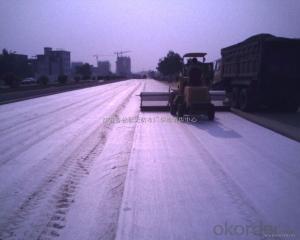Polyester Geotextile for Road Construction
- Loading Port:
- Qingdao
- Payment Terms:
- TT or LC
- Min Order Qty:
- 10000 m²
- Supply Capability:
- 500000 m²/month
OKorder Service Pledge
OKorder Financial Service
You Might Also Like
1. Geotextile Description
Polyester non woven geotextile is made from polyester short fiber by non woven needle punched manufacturing process, it has isolation, filtration, drainage, reinforcement, protection and maintenance function.
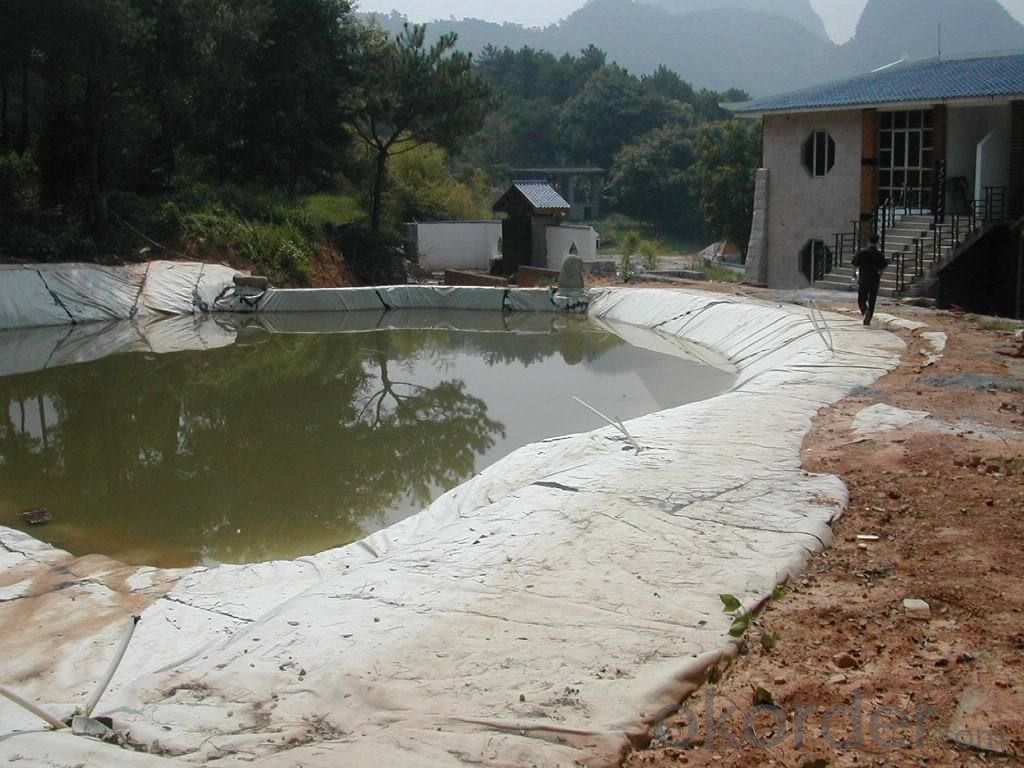
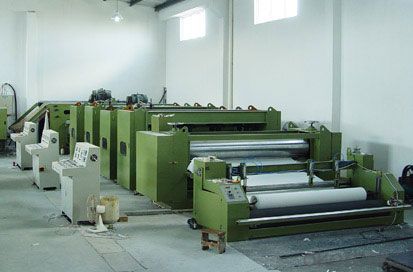
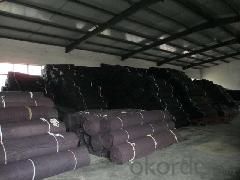
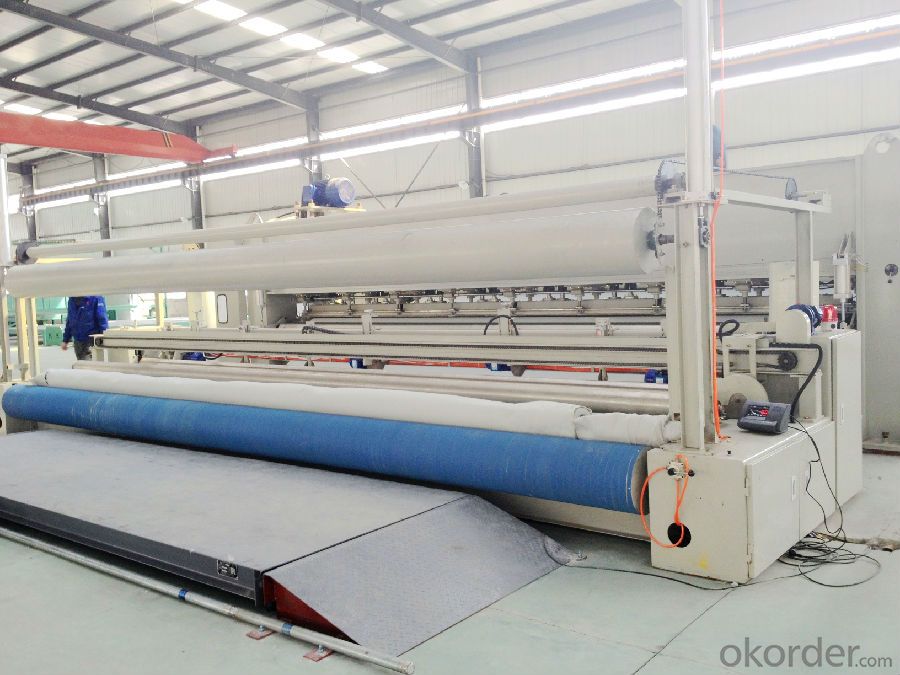
2. Polyester Nonwoven Geotextile Specification:
No | Project | Index | ||||||
1 | Breakage Strength KN/m≥(MD) | 20 | 30 | 40 | 50 | 60 | 80 | 100 |
2 | Breakage Strength KN/m≥(CD) | 15 | 22 | 28 | 35 | 42 | 56 | 70 |
3 | Elongation Rate (MD,CD) ≤ | 28 | ||||||
4 | Trapezoidal Tearing Strength | 0.3 | 0.45 | 0.5 | 0.6 | 0.75 | 1.0 | 1.2 |
5 | Burst Strength KN≥ | 1.6 | 2.4 | 3.2 | 4.0 | 4.8 | 6.0 | 7.5 |
6 | Vertical Permeability Coefficient cm/s | 10-1~10-3 | ||||||
7 | Sieve size(O95) mm | 0.08~0.5 | ||||||
8 | Unit weight g/m2 | 120 | 160 | 200 | 240 | 280 | 340 | 400 |
9 | Thickness mm | 0.40 | 0.48 | 0.60 | 0.70 | 0.80 | 1.00 | 1.25 |
10 | Variation % | ±10 | ||||||
3. FAQ:
We have organized several common questions for our clients, may help you sincerely:
Q1: How about your company?
A1:Our company are one of the largest geosynthetic products supplier in the world.We have the products experience more than 20 years.Already export to USA/Germeny/Australia/Zambia/Brazil etc.more than 20 countries.Almost 10years.Our products including Geocell/Fiberglass Geogrid/Geomembrane/Geotextile/Geonet etc.
Q2:Can you send samples to us ?
A2:Yes , free samples could be provided , but customer need pay for the freight cost .
After order placed , the freight charge could be refund .
Q3:What’s your Payment term ?
A3:T/T , L/C , Western Union,Paypal ...
Q4:What’s your manufacture process time ?
A4:Usually within 20 days
- Q:How do geotextiles aid in the protection of geomembranes?
- Geotextiles aid in the protection of geomembranes by acting as a protective barrier between the geomembrane and the surrounding soil or other materials. They prevent direct contact and potential damage from sharp objects, rocks, or roots, while allowing for the drainage of water and gases. This helps to extend the lifespan of the geomembrane and maintain its integrity, ensuring effective containment and protection in various applications such as landfills, ponds, or construction projects.
- Q:How do geotextiles improve the performance of geofabrics?
- Geotextiles improve the performance of geofabrics by providing additional strength and stability to the materials. They act as reinforcement layers, preventing the soil particles from shifting or migrating, thus enhancing the overall durability and functionality of geofabrics in various civil engineering applications.
- Q:How do geotextiles improve the performance of foundations?
- Geotextiles improve the performance of foundations by providing separation, filtration, and reinforcement functions. They prevent the mixing of different soil layers, allowing for better load distribution and reducing the risk of settlement. Geotextiles also act as filters, allowing water to pass through while retaining soil particles, which prevents clogging and maintains the stability of the foundation. Additionally, geotextiles reinforce the soil, increasing its strength and enhancing the overall stability and load-bearing capacity of the foundation.
- Q:How do geotextiles improve the performance of geogrids?
- Geotextiles improve the performance of geogrids by acting as a separator, preventing the mixing of different soil layers and allowing for better load distribution. They also provide filtration, allowing water to pass through while preventing the migration of fine particles, which helps in maintaining the stability and longevity of the geogrid. Additionally, geotextiles act as a cushioning layer, reducing the potential for damage to the geogrid and enhancing its overall effectiveness in reinforcement applications.
- Q:What are the different geotextile installation techniques in reinforcement?
- There are several geotextile installation techniques used in reinforcement, including direct placement, wrap-around, and anchor trenching. In direct placement, the geotextile is simply laid directly on the ground and covered with soil or aggregate. Wrap-around technique involves placing the geotextile around the object being reinforced, such as a pipe or retaining wall, and securing it in place. Anchor trenching involves burying the geotextile in a trench and anchoring it with soil or other materials to provide additional strength and stability.
- Q:Can geotextiles be used in temporary erosion control applications?
- Yes, geotextiles can be used in temporary erosion control applications. They are often used to stabilize soil and prevent erosion in construction sites, temporary roadways, and other areas where erosion control is needed temporarily. Geotextiles can effectively prevent soil erosion by providing a barrier that holds soil particles in place while allowing water to pass through.
- Q:How do geotextiles help in preventing sinkhole formation?
- Geotextiles help in preventing sinkhole formation by providing a stable base for the soil and reducing the risk of erosion. They act as a barrier to prevent the movement of soil particles, thus preventing the formation of voids or cavities that can lead to sinkholes. Additionally, geotextiles can improve the overall structural integrity of the soil, enhancing its load-bearing capacity and minimizing the potential for sinkhole development.
- Q:How long do geotextiles typically last?
- Geotextiles typically have a lifespan of around 15 to 25 years, although it can vary depending on the specific material used, environmental conditions, and the level of stress they are subjected to.
- Q:How are geotextiles used in slope stabilization?
- Geotextiles are used in slope stabilization by providing reinforcement and erosion control. They are placed over the soil surface or within the slope to prevent soil movement and erosion. Geotextiles help to increase the stability of the slope by distributing the load and reducing the risk of landslides. Additionally, they enhance the drainage capabilities of the slope, reducing the pressure on the soil and minimizing the risk of erosion.
- Q:What are the key factors affecting the hydraulic conductivity of geotextiles?
- The key factors affecting the hydraulic conductivity of geotextiles include the porosity of the fabric, the thickness and density of the fibers, the weave or structure of the fabric, the surface roughness, and the presence of any clogging or fouling agents.
1. Manufacturer Overview |
|
|---|---|
| Location | |
| Year Established | |
| Annual Output Value | |
| Main Markets | |
| Company Certifications | |
2. Manufacturer Certificates |
|
|---|---|
| a) Certification Name | |
| Range | |
| Reference | |
| Validity Period | |
3. Manufacturer Capability |
|
|---|---|
| a)Trade Capacity | |
| Nearest Port | |
| Export Percentage | |
| No.of Employees in Trade Department | |
| Language Spoken: | |
| b)Factory Information | |
| Factory Size: | |
| No. of Production Lines | |
| Contract Manufacturing | |
| Product Price Range | |
Send your message to us
Polyester Geotextile for Road Construction
- Loading Port:
- Qingdao
- Payment Terms:
- TT or LC
- Min Order Qty:
- 10000 m²
- Supply Capability:
- 500000 m²/month
OKorder Service Pledge
OKorder Financial Service
Similar products
New products
Hot products
Related keywords
